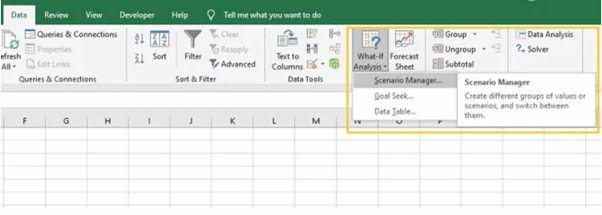As humans, we often like to overthink. We create scenarios in our heads and imagine ourselves in different situations to prepare ourselves for similar situations in the future.
Any successful person would tell you that planning and making the right decisions are essential for success. Without making the correct decisions and making strategies for the future to deal with unprecedented events, it is nearly impossible to succeed in life.
Besides humans, businesses also have to plan and make strategies for the future to ensure their growth. However, the question arises, what is the primary technique that enables businesses to make strategies for the future?
In this article, we will be discussing the what-if analysis. It is one of the most used techniques to see how the outcomes will change if the scenario or variables change.
A what-if analysis aims to determine the potential outcomes based on varying conditions. It is used to see the impact of different scenarios, both positive and negative, on the outcomes. However, the primary purpose of a what-if analysis is to provide valuable insight to make more informed business decisions.
What-if analysis helps businesses to make strategies to counter potential threats in the future. For example, currently, businesses all across the globe are worried about what if another wave of COVID-19 arrives.
To counter this threat, businesses can use what-if analysis. The what-if analysis will help businesses to make suitable strategies to counter problems arising from new waves of COVID-19 in advance.
Project management is an essential part of any business. You may not know, but what-if analysis is significant in project management. It helps project managers create a realistic and accurate project timeline.
Project managers use what-if analysis to remove uncertainty from the future and calculate the possible outcomes. For example, the project manager of a construction firm will use what-if analysis to analyze the possible scenarios that can occur while executing the project, such as the breakdown of machines, disruption in the supply of raw materials, etc.
However, with the help of what-if analysis, the project manager can suggest measures to prevent such unwanted events that will cause a delay in the project. Moreover, what-if analysis will enable the project manager to make accurate predictions about the project, leading to cost savings.
Now that we have explained the significance and use of what-if analysis, let's proceed further and learn more about the technique.

What-If Analysis as a Brainstorming Technique
Brainstorming is a very productive technique businesses use to solve different problems. The brainstorming techniques allow the employees to gather around and share ideas to solve different problems.
As we discussed earlier, what-if analysis is used for making strategies to counter unexpected events that can take place in the future. The process of making strategies by discussing ideas to solve future problems is considered brainstorming itself.
The what-if analysis is a structured way of brainstorming to understand risks and explore alternative solutions. It is a risk management method because it focuses on finding solutions.
Collectively thinking about "what if" questions and discussing scenarios makes the what-if analysis a brainstorming technique.
How to Conduct What-If Analysis
We should update ourselves with skills that can help in various aspects of life. For example, the inclusion of what-if analysis can change your life drastically. It will enable you to make well-informed, correct business and personal life decisions.
Now that we have discussed how useful what-if analysis is let's proceed further to learn how to carry out the what-if analysis.
Team Formation
Businesses need to have competent teams that can carry out operations. Therefore, the first step of conducting the what-if analysis is to construct a team comprising talented people with expertise in problem-solving.
Businesses can form a team comprising experts from all departments who can brainstorm together and help develop strategies and decision-making processes.
For example, a construction firm that wants to conduct a what-if analysis can gather experts from the HR, Procurement, and Finance departments so that they can discuss different scenarios that can arise in the future. After discussing the scenarios, they can devise a combined strategy to counter them.
Development of "What If" Questions
After the team is gathered, the second step is forming "what if" questions. Finally, the team jointly comes up with scenarios that can take place and then put them into words in the form of questions.
"What if" questions identify the risks that lie ahead. Continuing the example of a construction firm, the HR expert can come up with the question, "What if the employees working on the project call strike?" or the Finance expert might raise the question, "What if the project exceeds the estimated costs?"
Assessment of Risk
The team analyses the list containing "what if" questions in this step. Then, they discuss all the possible risks and consequences the business will have to deal with if any of the discussed scenarios occur.
The team exchanges ideas and discusses in detail the positive and negative impacts of each scenario so that if any of the scenarios occur, the company is prepared to deal with them in advance.
Develop Recommendations
Once the threat is identified, it is essential to develop a strategy to counter it. After assessing all the scenarios, the team makes recommendations for decision-making and dealing with the negative impacts of these potential scenarios.
Looking at our previous example, the construction firm team will now develop recommendations to solve the problems arising from the "what if" questions. For example, to deal with the strikes that employees may hold in the future, it may be suggested that the employees should sign an agreement in advance that they won't participate in any protest.
Evaluation
It is essential to review plans after making them in life since they sometimes need minor adjustments. Similarly, in the last step of the what-if analysis, all the recommendations are reviewed so that amendments can be made if needed.
The whole analysis is reviewed again in the end. If the team feels that some gaps are present, then these gaps are filled by adding more what-if questions or recommendations.

Examples of What-If Analysis
You may have understood what-if analysis functions and how it helps businesses and people in planning and decision-making. Now we will look at some of the examples of what-if analysis so that you get a better understanding of it.
Example 1
A bakery sells one cake for $20, while the cost of making one cake is $15. The remaining $5 is the profit earned by the baker per cake.
Scenario
What if the prices of raw materials increase in the future and the cost of making one cake increases to $20?
Recommendation
Increase the price of the cake to $25 so that the profit is maintained.
Example 2
Company A has to finish the project within 60 days. A project manager has estimated the project's completion time within 60 days if the work is done at an average pace and the project is not disrupted by any reason.
Scenario
What if the work on the project is disrupted due to bad weather?
Recommendation
Increase the pace of the work so that the project doesn't exceed the due date, even if the work is disrupted for a few days.

Advantages of Using What-If Analysis
Till now, we have talked a lot about what-if analysis. We even showed you how a what-if analysis is conducted. Now we will be looking at why people prefer using what-if analysis and what are the advantages of using it.
Helps In Predicting the Outcomes
The worst thing for businesses is uncertainty. A business wants its employees to predict future outcomes to plan and make strategies accordingly. The more the predictions are accurate, the more business benefits.
What-if analysis can be used by project managers to predict how a change in outcome will be observed if variables change. This helps project managers to plan in advance so that the changed outcome doesn't take them by surprise.
Well Informed-Decisions
Failure and success of a business depend upon how the decisions are taken in that business. Therefore, it is essential to make well-informed decisions to achieve growth and succeed. First, however, the question arises of how a business can make well-informed decisions.
What-if analysis helps businesses make well-informed decisions because it helps them weigh the positive and negative impacts of scenarios and make strategies accordingly. Moreover, since it enables businesses to make strategies in advance, the damage can be prevented.
Helps In Managing Finances
While running a business, managing finances is one of the most challenging things. Moreover, while conducting projects, the companies must have the correct estimations about the budget, or else problems can be created.
Since what-if analysis helps analyze all possible scenarios, it also improves the budgeting estimates. For example, a project manager will consider all possible scenarios and keep a flexible budget or funds in the backup so that they can be consumed if needed.

What-If Analysis In Excel
We have discussed the significance and advantages of what-if analysis. We also got a general idea of the process through which what-if analysis is conducted. However, now we will discuss how what-if analysis is conducted on excel.
Excel is the leading software through which what-if analysis is conducted. The what-if analysis in Excel is conducted by changing the values in cells to determine how these changes will change the outcome.
There are three different tools through which what-if analysis can be conducted in Excel. In this section, we will be looking at each of them closely.
Goal Seek
Goal Seek is a simple way to perform the what-if analysis. For example, suppose you know the outcome you want to achieve. In that case, the Goal Seek tool will help you to reach your outcome by mathematically altering the single variable in the equation.
The Goal Seek tool represents how one value impacts the other in the formula. It tells the user what value to put in the input cell to get the desired result. The Goal Seek tool is used for cases where you know what outcome you want but don't know under what circumstances you will obtain it.
There are plenty of video tutorials through which you can easily carry out the what-if analysis with the Goal Seek tool in Excel. Following, you can see where you can find the goal seek tool to use for your financial analysis.

Scenario Manager
Besides the Goal Seek tool, scenario manager is another tool through which what-if analysis can be conducted. This tool is more advanced than the goal seeker since the scenario manager can compare hypothetical situations. It allows you to define up to 32 different variables by changing one or more values simultaneously. Moreover, you can save each scenario for comparative purposes and later see the impact of each scenario on your data.
The scenario manager allows you to edit, name, or describe your scenario briefly. Working with the scenario manager, only the constant values change while cells with formulas remain unchanged. Using the scenario manager also enables us to save many scenarios and then compare the results of these scenarios with each other.
Following, you can see how to access the scenario manager in Excel.

Applying what-if analysis with the help of a scenario manager is relatively easy. Many videos are available on the internet from which you can learn how to use the scenario manager.
Data Tables
The last tool we will discuss for what-if analysis is data tables. The data table has a limitation of making adjustments up to one or two variables. However, it can have unlimited possible values.
The data table makes it easier for readers to read the scenarios and compare them since they are placed side by side.
You can access the data tables by clicking the what-if analysis in the toolbar. In addition, you can find some informative videos that will teach you how to conduct what-if analysis with data tables.
What-If Analysis Besides Excel
Excel is considered one of the best software for conducting a what-if analysis. However, Excel is not the only software to conduct the what-if analysis. For example, NH360 is another scenario planning software in which you can carry out what-if analysis.
This software is specially made for scenario planning. It is very easy to use and helps you to visualize possible scenarios.
What-If Analysis: Final Word
Today's article was about what-if analysis. In today's article, we discussed how important it is to make well-informed decisions and make strategies in business. Both of them are possible with the help of what-if analysis.
What-if analysis holds great significance as it helps in visualizing all the possible scenarios that can take place in the future. As a result, decisions are made, and planning is done in advance, which benefits businesses.
What-if analysis can also be considered a brainstorming technique since it allows people to think together and exchange ideas to solve problems.
The analysis itself is very easy to conduct. It has five easy steps, after which you are done making a strategy to combat any possible scenario.
What-if analysis has great significance, and it is a very beneficial tool for businesses since it helps project managers to make the right predictions about the projects. Moreover, it helps the project manager estimate the right project budget.
The software used to conduct the what-if analysis is Excel. There are three different tools present in Excel to conduct what-if analysis. All of them are very beneficial and easy to use. However, other software is also used to conduct what-if analysis besides Excel. We hope this article will help you understand the significance and use of what-if analysis.









